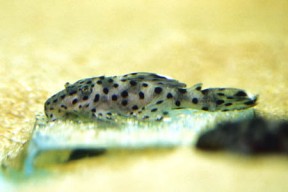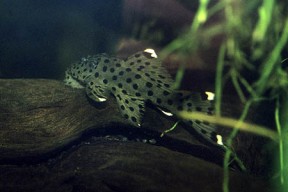Leporacanthicus joselimai
Sultan Plec, L264
Classification
Loricariidae, Subfamily: Ancistrinae
Distribution
Rio Tapajós, Brazil.
Habitat
A reophilic species that lives in rapids and other fast-flowing waters amongst rocks or driftwood snags.
Maximum Standard Length
6″ (15cm).
Aquarium SizeTop ↑
48″ x 12″ x 12″ (120cm x 30cm x 30cm) – 108 litres.
Maintenance
A spacious tank is required, preferably with a sandy substrate. Provide hiding places and shade with some big chunks of driftwood and smooth rocks. Dim lighting is also beneficial, and it’s imperative that the water is highly oxygenated, preferably with a good amount of movement. Consider the use of powerheads or large airstones to produce the desired effect. An efficient filter is needed to deal with the large amounts of waste it produces.
Water Conditions
Temperature: 77-81°F (25-27°C).
pH: 6.0-7.5
Hardness: 2-15°H
Diet
These prefer a meaty diet, which can consist of live and frozen foods such as bloodworm, chopped mussel and prawn and sinking dried foods. Algae and other vegetable matter is not often taken, but the occasional slice of cucumber or courgette might be nibbled at.
Behaviour and CompatibilityTop ↑
Ideal tankmates include characins, peaceful South American cichlids and catfish such as Corydoras and other small Loricariids. In a biotope setup with a lot of water movement choices are more limited, but possibilities include characins such as Anostomus, Hemiodus and reophilic cichlids like Retroculus or Steatocranus. It’s territorial with conspecifics, with this behaviour being particularly pronounced among males, so make sure there is plenty of tank space and potential territories if you want to keep a group.
Sexual Dimorphism
When viewed from above mature males have a noticeably longer and wider head than females. They also have a bigger dorsal fin and more numerous odontotes than females.
Reproduction
Has been achieved in the hobby, but unfortunately I haven’t read the report. It’s a cave spawner and presumably this occurs in a similar fashion to Ancistrus but on a larger scale.
NotesTop ↑
Leporacanthicus species are commonly referred to as “vampire plecs”. This is derived from the unique upper jaw dentition exhibited by members of this genus, unsurprisingly consisting of two large teeth or “fangs”. The exact use for these is unknown, but they’re probably utilised to grip prey items such as snails or other aquatic invertebrates in some way. Another feature shared by all Leporacanthicus is a small bony growth of unknown use on top of the head. This particular species is a very good looking fish, particularly when young when it has striking white fin tips. Unfortunately these fade as the fish grows and often disappear completely.
When buying one of these (or any Loricariid), be sure to check the fish has a rounded belly and that its eyes aren’t sunken, as these are classic signs of emaciation in newly imported specimens.




